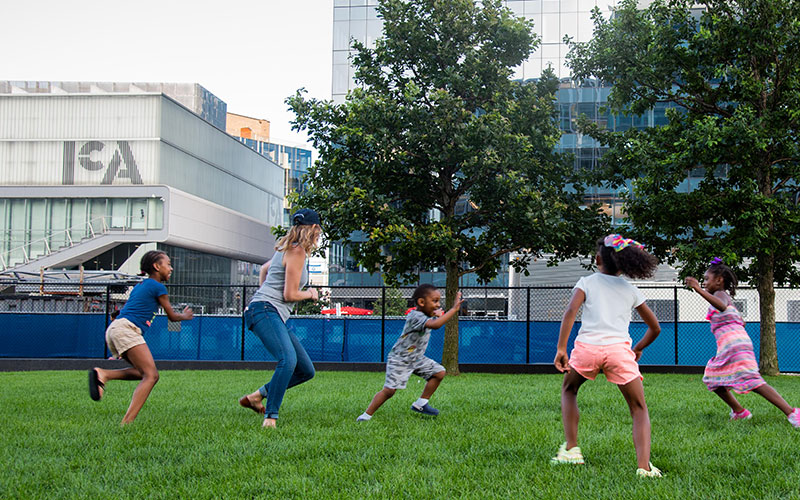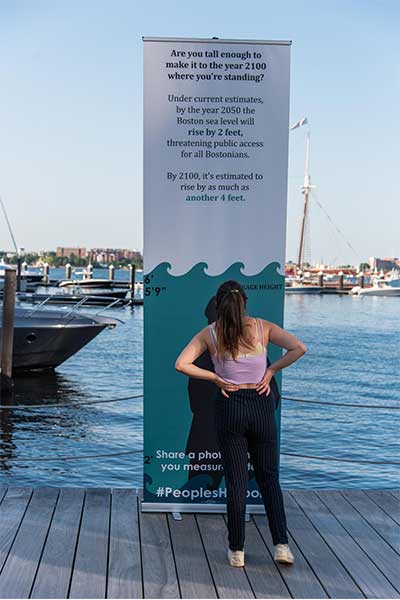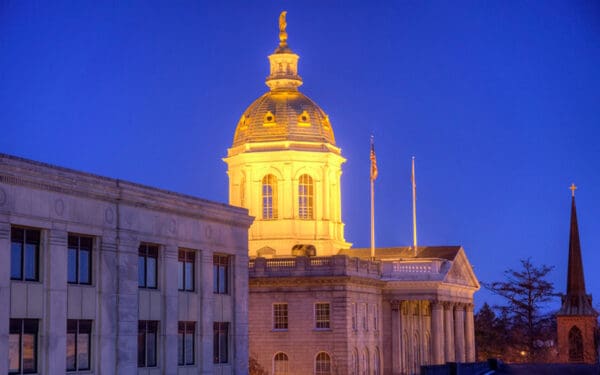
Children played on the Public Green in the Seaport at our annual Pitch a Blanket event, which both celebrated access to public space and reminded people of coming climate crisis impacts. Photo: Tim Briggs
More than 75 people from neighborhoods across greater Boston joined CLF and our waterfront partners to celebrate Boston’s public spaces on Thursday evening. The after-work party on the Public Green in the Seaport District was our third “Pitch a Blanket” event, which encourages Greater Boston residents to claim their legal right to get out and enjoy our waterfront’s open spaces. For some people who attended the event, it was their first visit to the Seaport.
These annual events – and the growing crowd they draw each year – show how much people around Boston care about protecting public access to the waterfront. They also give people the chance to express their shared frustration about privatization of waterfront spaces and poor public access. This combination of factors has made the waterfront feel unwelcoming to many but the wealthy.
Those sentiments are echoed in a just-released CLF survey of Boston residents about the waterfront and Boston Harbor. That means we – and the City – have work to do if we’re going to ensure that Boston Harbor remains the People’s Harbor: a vibrant, welcoming, and accessible place for all.
Overdevelopment, Gentrification Top List of Concerns About Boston Harbor
Thursday night’s celebration attracted a diverse crowd from all across the city, showing that Boston Harbor truly could be the People’s Harbor – a place that belongs to all residents, not just those wealthiest enough to afford a home in the city’s newest neighborhood.
That’s the good news. The bad news is that more clearly needs to be done if we are going to achieve that ideal every day.
We recently commissioned MassINC Polling Group to survey Boston residents on how they think about and use the waterfront and Boston Harbor. We found that residents see the high cost of the neighborhood’s amenities and the lack of reliable public transportation as the greatest barriers to enjoying the waterfront. Overdevelopment, expensive attractions, and gentrification are among the greatest threats to the area, according to survey respondents.
Even more concerning: some Black and Latinx Bostonians say they don’t feel welcome in the booming waterfront of their own city, though few white residents express the same concern.
Making the Seaport Neighborly
That’s one reason why, for this year’s Pitch a Blanket event, we wanted to make sure that families and individuals from Dorchester, Roxbury, Chelsea, East Boston, and other neighborhoods were part of the celebration. Residents from across the Greater Boston area paid billions to clean up the harbor. We should all benefit from that massive public investment, no matter how close we live to the waterfront. We worked closely with our partners at The America Cities Coalition (TACC) and GreenRoots to get the word out about the event, and many people from across the city came out to join us.
It was a beautiful evening to be on Boston’s Waterfront. However, as soon as we arrived to set up some lawn games, we were reminded of how little waterfront staff understand our rights to be on public space. A property manager approached us and said he wanted to make sure we were not there for any “political purposes.” In fact, no one can stop you from expressing your political views on public space. Unfortunately, the threat to freedom of assembly is one of the many issues with the privatization of public spaces that residents are coming up against.
But we did not let that brief encounter with the property manager deter us from our celebration. Before long, children were running around the grassy lawn; families were enjoying snacks; and people were playing games of corn hole, checkers, and Jenga. CLF president Brad Campbell took a few moments to welcome people and remind everyone that “you have a right to be here and that right belongs to you no matter what community you come from.”

And while the focus of the evening was celebrating our public spaces, we also wanted to remind people of another looming threat to our waterfront: sea level rise. By the year 2100, Boston’s sea level is projected to rise by six feet. We created a special sign created for this year’s Pitch a Blanket event to bring that message home, letting attendees see how well they measured up to the two to six feet of sea level rise estimated for the neighborhood by the end of this century. People posted photos with the hashtag #peoplesharbor.
What’s Next?
Protecting public access from gentrification is critical, and so is understanding how the climate crisis threatens our legal rights on the waterfront. A study we released earlier this year showed that 1.6 million square feet of open space across Boston’s neighborhoods will be at risk of flooding by the end of this century. The Seaport is extremely vulnerable, with more than 13 acres of waterfront open space in danger of flooding during a 100-year storm by 2100.
Increasing sea level rise, along with more frequent and intense storms, threatens to inundate many areas of public space for good. A flooded park or section of the Harborwalk is one that is no longer available to the public.
While we continue to raise awareness among Boston and Massachusetts residents of their rights to public access, we also want to make sure they are conscious of the significant risk climate change itself brings both to Boston’s public health and safety and to its right to public access.
We’re continuing both of our efforts to promote public access and highlight the threat of climate change. Will you join us? Visit our People’s Harbor page and sign our pledge. Together, we can take back our People’s Harbor and create a healthy, thriving waterfront – for all.



